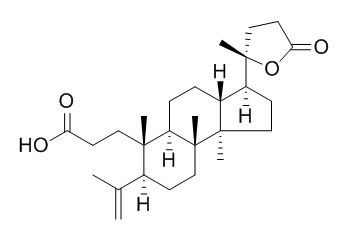Eichlerialactone
Eichlerialactone and ethyl eichlerianoate show antimycobacterial activity against mycobacterium tuberculosis H37Ra, with minimum inhibitory concentration in the range of 25–50ug/mL; eichlerialactone exhibits good antibacterial activity against both the Gram-positive pathogens. Eichlerialactone is weakly cytotoxic to a breast cancer (BC) cell line.
Inquire / Order:
manager@chemfaces.com
Technical Inquiries:
service@chemfaces.com
Tel:
+86-27-84237783
Fax:
+86-27-84254680
Address:
1 Building, No. 83, CheCheng Rd., Wuhan Economic and Technological Development Zone, Wuhan, Hubei 430056, PRC
Providing storage is as stated on the product vial and the vial is kept tightly sealed, the product can be stored for up to
24 months(2-8C).
Wherever possible, you should prepare and use solutions on the same day. However, if you need to make up stock solutions in advance, we recommend that you store the solution as aliquots in tightly sealed vials at -20C. Generally, these will be useable for up to two weeks. Before use, and prior to opening the vial we recommend that you allow your product to equilibrate to room temperature for at least 1 hour.
Need more advice on solubility, usage and handling? Please email to: service@chemfaces.com
The packaging of the product may have turned upside down during transportation, resulting in the natural compounds adhering to the neck or cap of the vial. take the vial out of its packaging and gently shake to let the compounds fall to the bottom of the vial. for liquid products, centrifuge at 200-500 RPM to gather the liquid at the bottom of the vial. try to avoid loss or contamination during handling.
Revista Brasileira de Farmacognosia2024, 34:1091-1100.
National Natural Science Foundation of China2024, pages 33.
Exp Ther Med.2019, 18(6):4388-4396
J Clin Med.2022, 11(13):3662.
Front Pharmacol.2019, 10:1025
Phytomedicine.2024, 128:155527.
Sci Rep.2024, 14(1):26330.
Molecules.2019, 24(4):E744
J Ethnopharmacol.2019, 244:112074
Evid Based Complement Alternat Med.2019, 2019:2135351
Related and Featured Products
Nat Prod Res. 2015 Mar 6:1-5.
Cytotoxicity and Synergistic Effect of the Constituents from Roots of Aglaia odorata (Meliaceae).[Pubmed:
25742723]
METHODS AND RESULTS:
Twelve compounds were isolated from the roots of Aglaia odorata. Their structures were established on the basis of NMR and MS data as rocaglaol (1), rocaglamide (2), Eichlerialactone (3), sapelins A (4), isofouquierone (5), eichlerianic acid (6), shoreic acid (7), agladupol E (8), 3-epimeliantriol (9), cleomiscosins B (10), 2β,3β-dihydroxy-5α-pregnane-16-one (11) and β-d-glucopyranos-1-yl N-methylpyrrole-2-carboxylate (12).
CONCLUSIONS:
Among them, compounds 1 and 2 showed significant cytotoxicity against human cancer cell (HL-60, SMMC-7721, A-549, MCF-7 and SW480) with IC50 values of 0.007-0.095 μM, while compounds 3-5 and 10 and 11 showed moderate to no cytotoxicity (IC50 0.43 to values >40 μM). Compound 6 showed only weak cytotoxicity (IC50 6.87 to >40 μM) and its epmier 7 was completely inactivite (IC50>40 μM) in the assay. However, potent synergistic effect was observed when the molar ratio of 6 to 7 is between 4:1 and 1:1.
Arch Pharm Res. 2008 Jan;31(1):21-7.
A new sesquiterpene and other terpenoid constituents of Chisocheton penduliflorus.[Pubmed:
18277603]
METHODS AND RESULTS:
A new aromadendrane sesquiterpene, allo-aromadendrane-10alpha, 14-diol (3), was isolated from Chisocheton penduliflorus (Meliaceae), along with two known sesquiterpenes: allo-aromadendrane-10beta, 14-diol (2) and allo-aromadendrane-10beta, 13, 14-triol (7). Six dammarane triterpenoids, including cabraleadiol (1), Eichlerialactone (4), cabraleahydroxylactone (5), cabralealactone (6), hollongdione (8) and dammaradienone (9), the coumarins scoparone and scopoletin, and vanillic acid were also isolated from the wood and leaves of this plant.
CONCLUSIONS:
Compounds 1-7 displayed antimycobacterial activity against Mycobacterium tuberculosis. Compounds 1, 4, 5 and 6 were weakly cytotoxic to a breast cancer (BC) cell line; whereas, compound 6 was moderately active against a small-cell lung cancer (NCI-H187) cell line.
Nat Prod Res. 2011 Oct;25(17):1621-8.
Biologically active constituents of Aglaia erythrosperma.[Pubmed:
22011221]
METHODS AND RESULTS:
From the fruits and leaves of Aglaia erythrosperma (Meliaceae), 10 chemical constituents were isolated and identified, i.e. the dammarane triterpenoids cabraleadiol (1), cabraleahydroxylactone (2), ethyl eichlerianoate (3), Eichlerialactone (4), aglinin A (5), cabralealactone (6), the aglaialactone 5,6-desmethylenedioxy-5-methoxy-aglalactone (7), the flavagline 4'-demethoxy-3',4'-methylenedioxy-methyl rocaglate (8) and two coumarins: scoparone and scopoletin.
CONCLUSIONS:
Flavagline 8 exhibited antimalarial activity with an IC(50) value of 7.30 μg mL(-1) and was strongly cytotoxic against small cell lung cancer (NCI-H187), epidermoid carcinoma (KB) and breast cancer (BC) cell lines, with IC(50) values of 2.17, 2.10 and 0.11 μg mL(-1), respectively. Aglinin A (5) displayed moderate cytotoxicity against all the three cancer cell lines, whereas ethyl eichlerianoate (3), cabralealactone (6) and the aglaialactone 7 were exclusively cytotoxic to NCI-H187 cell line. Cabraleahydroxylactone (2) showed antiviral activity against herpes simplex virus type-1 with an IC(50) value of 3.20 μg mL(-1), in comparison with the standard acyclovir (IC(50) = 1.90 μg mL(-1)). When tested for antimycobacterial activity against Mycobacterium tuberculosis H(37)Ra, compounds 1-4 and 6-8 displayed minimum inhibitory concentration in the range of 25-50 μg mL(-1).



